
For those who can afford it, it's possible to take pleasure flights into space...
 But for now, space travel is just a dream for most of the population. However, if we could pilot a spacecraft, we wouldn't need the skill of controlling the space around our rockets. Although there is 'space junk' orbiting the earth, there would be virtually no chance of bumping into another spaceship coming the other way or being hit from behind by an impatient 'space boy racer'.
But for now, space travel is just a dream for most of the population. However, if we could pilot a spacecraft, we wouldn't need the skill of controlling the space around our rockets. Although there is 'space junk' orbiting the earth, there would be virtually no chance of bumping into another spaceship coming the other way or being hit from behind by an impatient 'space boy racer'.
Back down here on the earth's surface, things are very different - especially for drivers.
Drivers need to keep a safe space between their vehicles and other road users, bollards, trees and walls, etc., and they need to do this all the time their vehicles are moving (or stopped in traffic) - it's helpful to think of this space as 'the safety bubble.
You can think of a safety bubble like a giant space helmet around your car - an invisible bubble.
In this lesson, we suggest a few ways to maintain this safety cushion at all times when you are driving.
During your driving test (and after you pass!), you must keep a safe space between yourself and other road users or obstructions. The examiner considers a couple of things:
1. Clearance & Obstructions: Ensure you leave plenty of room to pass stationary vehicles or obstructions, and drive cautiously, pedestrians can step into the road, and car doors can open without warning.
2. Following Distance: Use the "2 Second Rule". Don't tailgate cars in front. When you queue in traffic, leave enough space to pull out and pass if the vehicle in front has problems.
The examiner will look for the following: 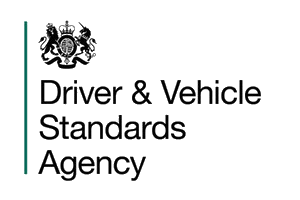
Good judgement of space
Adequate clearance from parked cars and other obstructions
A safe speed and space for the weather conditions
A safe distance from the vehicle in front when moving.
A reasonable gap from the vehicle in front when stopping in lines of traffic.
 While attempting to break the land speed record, people have driven rocket-powered cars across vast open salt flats (desert-type areas).
While attempting to break the land speed record, people have driven rocket-powered cars across vast open salt flats (desert-type areas).
If a vehicle fails mechanically at 400+ mph on a salt flat, the driver will be relatively safe as long as the systems work as designed, and the vehicle doesn't flip over. The driver will stay safe because there is lots of space and nothing hit.
On the other hand...
If a driver runs out of space at speeds as low as three mph on the local high street, there is a risk of doing severe damage to a young or old pedestrian - possibly resulting in a fatal accident.
The answers to the question "How much space do I need?" are:
It depends how fast you are going
It depends on how alert you are
It depends on your concentration and the distractions around you
It depends on your observation
It is often more space than drivers think they need!
A good starting point for understanding 'safe space' would be to learn the stopping distances shown in the Highway Code. Stopping distances are about the gap you need to leave in front.
A great way to appreciate just how much space you need is to write out the distances on a scrap of paper and then take it out into the street near your home. Pace out the distance for each speed - you might be surprised just how far it can take to stop.
The stopping distances in the Highway Code are for an alert driver on a dry road in a well-maintained car. It can often take longer to stop - at least double the distance in the wet!
If you are on a clear road, you should always be able to stop safely. You should allow enough stopping distance for your speed. Ideally, you need to be able to stop within half of the clear space you can see ahead.
You need to be able to stop in half the space to allow for other drivers. For example, if a car comes around a bend towards you on your side of the road, that driver will need space to stop or take avoiding action - the other half of the clear space is for them.

The safety space in front of your car is the easiest to control. You can adjust the gap between yourself and the vehicle in front by varying your speed.
Your forward safety gap must always be large enough for you to stop safely if necessary; an easy way to maintain this gap on a dry road is to use the 'two-second rule'. Applying this rule is easy.
Look ahead to find a fixed reference point beyond the vehicle in front. This could be a tree, a phone box, a lamp post, a motorway bridge or any other fixed point.
As the vehicle in front passes the reference point, recite the following phrase out loud at an average speaking rate:
"Only a fool breaks the two-second rule."
This should take approximately two seconds to say. You should have finished the phrase as, or before, you reach the fixed reference point.
If you pass the point before you finish speaking, you are too close to the vehicle in front, ease back and try again.
In poor weather conditions, your gap should be at least double - four seconds or more.
By practising the exercise above repeatedly when you drive, you will soon develop your judgment to maintain a safe distance automatically. You will also feel more relaxed behind the wheel. Ask your driving instructor to demonstrate the two-second rule and help you to apply it.
The video below is quite old - made in 2007 - but the message is just as relevant today as it was back then.
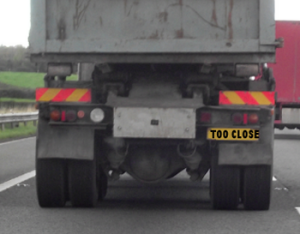
Sometimes drivers get stuck behind slower-moving vehicles, for example, lorries or cars towing caravans, even though there is a safe opportunity to overtake.
This happens because they are following too close behind and can't see past the vehicle ahead - because of this, they miss their overtaking opportunity.
Hold your hand in front of your face about two inches from your eyes, and consider what you can see directly in front of you (not while driving!). Now, keeping your hand in front and in line with your eyes, gradually move it away and notice how your view of the world in front is changing. As you move your hand away, you can see more of the world around you and what is directly in front of you.
If you apply the same principle to vehicles in front, especially large vehicles, you will find that by keeping well back, you have a wider field of view ahead. This might mean leaving a gap larger than two seconds (remember, two seconds is your minimum gap). By keeping well back, you will be in a much safer position to overtake, and as a result, you will probably complete your journey quicker.
Being held up because you can't overtake is one problem. Being held up because you have had an accident is an entirely different situation altogether - you could be held up for months.
By keeping well back from the vehicle ahead, you will be able to see the brake lights and other actions of vehicles that are further up the road, giving you an early warning of danger and reducing your risk of having a crash.
Another reason for not following too close to large trucks is that if you can't see the driver's mirrors, the truck driver can't see you.
In the first picture, it's almost impossible to see past the truck; this means that if a driver in front of the truck stops suddenly, the first warning you will get will be when the brake lights show. You probably wouldn't have enough time to stop.
In the second picture, the longer gap enables the driver to see further ahead beyond the truck. The driver can see what's happening ahead of the truck. This tells them that there is a bend and no opportunity to overtake.
In the third picture, our driver is further back still and can see much more of the road ahead. The motorcyclist looks like he wants to pass the truck, but from where the bike is positioned, the rider's view will be more like the first image. If the rider was further back he would see overtaking opportunities much sooner - and have more time to overtake safely.
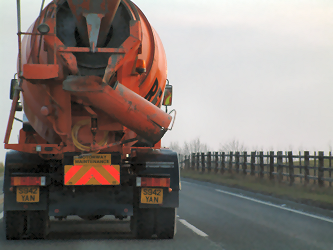

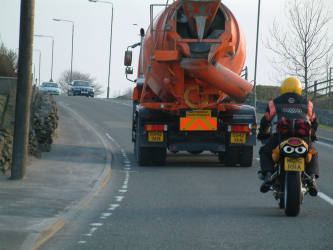
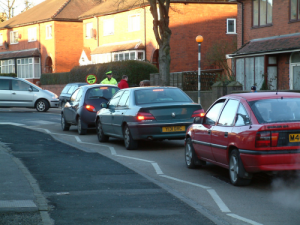 The two-second rule will help you to keep a safe distance when your car is moving, but you must also consider the gap to the front when you stop in traffic queues.
The two-second rule will help you to keep a safe distance when your car is moving, but you must also consider the gap to the front when you stop in traffic queues.
What if the car in front rolls back or breaks down?
What if your foot slips off the clutch?
What if you are facing downhill and your handbrake fails?
Always leaving enough room to steer around the vehicle in front (about 2 metres) will help ensure your safety.
An easy way to measure a reasonable gap to the front is to use the 'tyres and tarmac' rule.
When you stop behind another vehicle, you should be able to see its rear tyres and some of the road surface behind them while sitting in your normal driving position.
In the picture, you can see a queue at a zebra crossing. The second car in the queue is a bit close to the first car - it's unlikely the driver of the second car can see the rear tyres of the car in front. If the first car breaks down, the short gap will make it very difficult to steer around it.
The third car in the queue, the red car, is in a much better position. The driver can probably see the tyres of the car ahead and will have enough space to steer around it in the event of a problem.

You need space to the sides to avoid pedestrians, cyclists, horses, dogs, oncoming vehicles and many other road hazards.
You can control this space by constantly watching the road ahead and to the sides - a visual scan - and then planning to leave sufficient space or stop.
Never commit yourself to a narrow gap unless you are confident that there is enough 'room for error' - although you might be able to squeeze through a tiny space comfortably, the other driver may not judge the gap as well as you do.
Some drivers might be impressed with their ability to 'whiz' through tight gaps - but trust me when I tell you - most other road users will see them as idiots.
Where there are parked cars, there can be many dangers, such as doors opening without warning, kids running out, or mothers pushing prams into the road. You will need to leave a gap to the left that would allow a car door to open without you having to swerve out of the way.
At speeds up to 30 mph, hold back behind cyclists until you can allow at least 1.5 metres clearance to pass them. At speeds above 30 mph you will need to give more space (two or three metres). A court ruling has defined the precedent that 'cyclists are entitled to wobble' - you would probably have a tough job proving the case against a cyclist!
If there's a broken-down vehicle on the hard shoulder of a fast road, move out to the next lane in case someone steps out.
If children are playing on the nearside footpath, check your mirrors and move out as far as is practical (or slow down to control the space to the left).
If you've ever been to a pantomime, you might have found yourself shouting, "Look behind you."
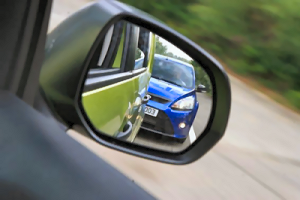 This is something that your driving instructor will probably say quite often (but hopefully not shout!).
This is something that your driving instructor will probably say quite often (but hopefully not shout!).
If you feel that the vehicle behind is following too closely, it probably is! This can be pretty frustrating, but it's nothing personal, not even if they flash you to get out of the way (they don't know you).
To find out more about the types of people who follow too close, read about 'Tailgating' in the Driver's Area, where you will discover how you can safely deal with them.
To protect yourself from tailgaters, you need to increase the safety gap in front of your car. When you do this, you will allow enough space for both you and the Driver behind to stop safely if an emergency arises ahead.
An easier way to control this gap on a clear road is to allow the following vehicle to overtake. Doing this will make no difference to your journey time but will increase your safety (in fact, this may reduce your journey time by the several weeks that would otherwise be spent in the hospital!).
With around 38 million vehicles licensed for use on UK roads, there will always be thousands of drivers ahead and thousands more behind - allowing a couple of others to overtake won't make any real difference!
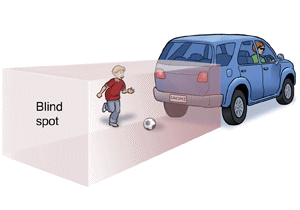
When reversing, you have direct control over your rear safety gap.
There are a couple of critical points to consider.
1. The first point is to ensure there is nothing behind before you reverse. This is particularly important when driving larger cars and cars or vans with limited rear view.
A low concrete bollard could do a lot of damage to your car. Even worse, your car could do a lot of damage to a pedestrian.
2. The other important point to remember here is to drive slowly; this makes it easier to manoeuvre, and you will be able to stop safely when taken by surprise by something or someone behind (you will be sooner or later).

Click here to complete the quiz for this lesson
(The page will open in a new window/tab)
You will find references for the answers in this lesson.
You can check your answers as you go along, or complete the full quiz before checking.
Leaving the check to the end is a good way to test yourself.
When you check or review your answers you will get a brief explanation of the answer.
Good Luck!